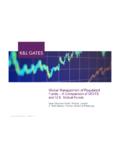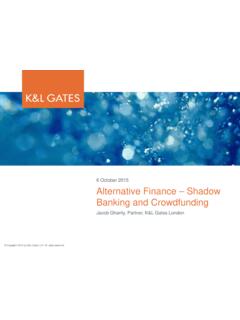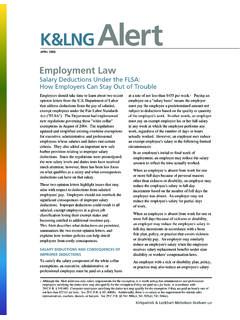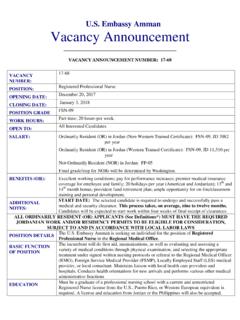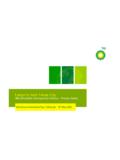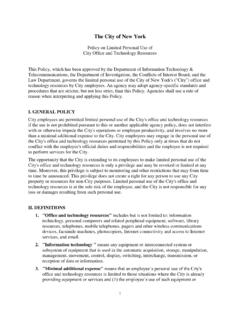Transcription of Reductions in Force: Strategies to Minimize …
1 1 Reductions in Force: Strategies to Minimize litigation Risk in DownsizingRosemary AlitoArlene Switzer SteinfieldBruce A. Strombom, PrincipalK&L GatesK&L GatesAnalysis Group, Newark Center1717 Main Street, Suite 2800601 S. Figueroa Street, Suite 1300 Newark, New Jersey 07102 Dallas, Texas 75201 Los Angeles, California 90017(973) 848-4000(214) 838-5525 (213) 896-4500 Bureau of Labor Statistics Unemployment rate in December 2007 Up from in December 2006 Mass Layoff* Events in the US 2005: 16,466 2006: 13,998 2007.
2 13,326 (through November 2007)*Mass layoff is defined by BLS as an event in which there are 50 initial claims for unemployment insurance filed against employer during a 5-week Reasons for Layoffs Business Demand contract cancellation/completion Insufficient demand Organizational Changes New ownership Restructuring/reorganization Financial Issues Bankruptcy Cost control/cost cutting/increase profitability Financial difficulties External Crisis Product recall Weather/Natural disaster Hazardous work environment Seasonal
3 IndustryConsiderations Before Undertaking a RIF Assessing the business need for terminating a large number of employees Alternatives to cutting non-personnel costs: (supplies, corporate travel, advertising and corporate sponsorships, suspending new initiatives) Alternatives to cutting personnel costs: Compensation cuts or freezes Reducing PTO and other benefits Prohibiting overtime Temporary shutdowns Hiring freezes Voluntary exit incentive programs Voluntary retirement programs Public relations (internal and external) Employee morale Impact on productivity3 RIF Considerations What is the goal reduce headcount or salary costs?
4 What selection criteria will be used? What process will be followed? Assessing legal exposure What benefits should be provided? How should the decision be communicated to employees, the media, the public?RIF Decision-MakingHow many employees will be terminated? Do you want to do it all at once, or in stages? Do you want to plan one RIF conservatively, and then proceed to undertake another RIF, if still necessary?First, determine the criteria, then apply goals of the the relative weight of multiple and assign various levels of decision-makers4 Discrimination Issues RIF decisions cannot be based on any protected characteristic.
5 Under federal law, protected characteristics include race, color, religion, sex, national origin, age (over 40), pregnancy, union activities, disability, FMLA leave status, military status. Under state and local laws, protected characteristics also include sexual orientation, marital/familial status, arrest/conviction record, and predisposing genetic traits, among other of RIF Discrimination Claims Disparate Treatment Direct Evidence ( Smoking Gun ) Disparate Treatment Indirect Evidence ( Pretext ) Disparate Impact Pattern or Practice5 Disparate Treatment Direct Evidence Direct evidence proves discrimination without the need for inference or interpretation.
6 Statements by a person involved in the decision making process that reflect a discriminatory animus may constitute direct Treatment Indirect Evidence Applies three-part burden shifting model of proof under McDonnell Douglas Corp. v. Green, 411 792 (1973) Step One the Prima Facie Case: Plaintiff is a member of a protected class Plaintiff was qualified to assume another available position Plaintiff was discharged Discharge occurred under circumstances giving rise to an inference of discrimination: , where a similarly situated person of lesser qualifications outside of the protected class was retained In age discrimination context, comparator need not be under age 40 but must be substantially younger than the plaintiff6 Disparate Treatment Indirect Evidence Step Two employer must articulate a legitimate non-discriminatory reason for the RIF.
7 Reorganization/restructuring business climate financial considerations cost cutting performance reviews sales/productivity need for particular skills/abilities Step Three Plaintiff has the opportunity to prove that the employer s stated reasons for the RIF decision was not the true reason for its actions but a mere pretext for unlawful Impact Under a disparate impact theory, plaintiffs can prove discrimination by showing that an employer s facially neutral RIF policies or procedures had an adverse impact upon a protected class.
8 Applies to both subjective and objective decision making. Watson v. Fort Worth Bank & Trust, 487 977 (1988). Proof of discriminatory intent is not necessary. Griggs v. Duke Power Co., 401 424 (1971). 7 Disparate Impact Statistical evidence is used to support disparate impact claims. Methods of measuring disparate impact Four-fifths rule federal enforcement agencies generally find disparate impact if protected class members are selected at a rates more than four-fifths (80%) of the rate for the group with the highest selection.
9 29 CFR (D). Standard deviation analysis statistically measures the difference between the actual numbers of the protected group in a sample and the numbers of the protected group that would be expected in a perfectly proportional process of selection from the appropriate labor pool. Courts generally find an adverse impact if the difference between the number of members of the protected class selected and the numberthat would be anticipated in a random selection system is more than two or three standard deviations.
10 Hazelwood School District v. United States, 433 299, 308-09 (1977). Disparate Impact If a plaintiff can show a disparate impact, the employer must demonstrate that the challenged practice is "job-related for the position in question and consistent with business necessity." 42 2000e-2(k)(1)(A)(i). The plaintiff then has an opportunity to show that that there is an available alternative employment practice that would satisfy the employer's legitimate interests without having a disparate impact on a protected class.
